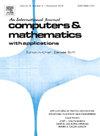A novel distributed-order time fractional derivative model of laser-induced thermal therapy for deep-lying tumor
IF 2.9
2区 数学
Q1 MATHEMATICS, APPLIED
引用次数: 0
Abstract
The laser-induced thermal therapy (LITT) scheme has proved great efficacy in tumor treatment. Therefore, the research between the heat conduction problems of LITT has become a hot topic in recent years. To seek rational constitutive relations of heat flux and temperature which can describe the heat transfer behavior of LITT, we develop a novel distributed-order time fractional derivative model based on the dual-phase-lag (DPL) model and Pennes bio-heat conduction model in this paper. Physical parameters of the governing equation are approximated using experimental data. Formulated model considers a spectrum of memory and nonlocal characteristics based on the DPL model. Distributed-order integrals are approximated by the summation of multi-fractional terms and fractional derivatives are discretized by the L1 scheme. Source item is introduced into the governing equation to verify the correctness of the numerical methods. The influences of the physical parameters on the tissue temperature are discussed and analyzed in details. Results demonstrate that the proposed model truly performs better compared to the classical Fourier's law and DPL model in describing the heat conduction behavior of LITT.
激光诱导热疗(LITT)方案已被证明在肿瘤治疗中具有显著疗效。因此,对 LITT 热传导问题的研究成为近年来的热门话题。为了寻求能够描述 LITT 热传导行为的热通量和温度的合理构成关系,本文在双相滞后(DPL)模型和 Pennes 生物热传导模型的基础上,建立了一种新型分布阶时间分导数模型。支配方程的物理参数是利用实验数据近似得到的。所建立的模型考虑了基于 DPL 模型的记忆和非局部特征谱。分布阶积分用多分项求和来近似,分项导数用 L1 方案离散化。为验证数值方法的正确性,在控制方程中引入了源项。详细讨论和分析了物理参数对组织温度的影响。结果表明,与经典的傅里叶定律和 DPL 模型相比,所提出的模型在描述 LITT 的热传导行为方面确实有更好的表现。
本文章由计算机程序翻译,如有差异,请以英文原文为准。
求助全文
约1分钟内获得全文
求助全文
来源期刊

Computers & Mathematics with Applications
工程技术-计算机:跨学科应用
CiteScore
5.10
自引率
10.30%
发文量
396
审稿时长
9.9 weeks
期刊介绍:
Computers & Mathematics with Applications provides a medium of exchange for those engaged in fields contributing to building successful simulations for science and engineering using Partial Differential Equations (PDEs).
 求助内容:
求助内容: 应助结果提醒方式:
应助结果提醒方式:


